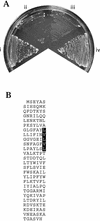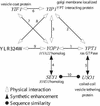Function of a plant stress-induced gene, HVA22. Synthetic enhancement screen with its yeast homolog reveals its role in vesicular traffic
- PMID: 12427979
- PMCID: PMC166633
- DOI: 10.1104/pp.007716
Function of a plant stress-induced gene, HVA22. Synthetic enhancement screen with its yeast homolog reveals its role in vesicular traffic
Abstract
Expression of the barley (Hordeum vulgare) HVA22 gene is induced by environmental stresses, such as dehydration, salinity, and extreme temperatures, and by a plant stress hormone, abscisic acid. Genes sharing high level of sequence similarities with HVA22 exist in diverse eukaryotic organisms, including animals, plants, and fungi, but not in any prokaryotic organisms. The yeast (Saccharomyces cerevisiae) HVA22 homolog, Yop1p, has been shown to interact with the GTPase-interacting protein, Yip1p. Deletion of YOP1 led to only a modest reduction of the stationary phase titer at 37C. A synthetic enhancement mutant screen was performed in the yop1 deletion background to identify genes interacting with YOP1. The open reading frame YOR165W (renamed SEY1 for synthetic enhancement of YOP1) was identified as a YOP1-dependent complementation gene. The yeast SEY1 is a homolog of the Arabidopsis RHD3 gene whose mutations cause the accumulation of transport vesicles near the tips of defective root hairs. The yeast double mutant of yop1 and sey1 is defective in vesicular traffic as evidenced by the accumulation of transport vesicles and the decrease in invertase secretion. Based on these observations, we suggest that Yop1p/HVA22 regulates vesicular traffic in stressed cells either to facilitate membrane turnover, or to decrease unnecessary secretion.
Figures









References
-
- Alexandre H, Rousseaux I, Charpentier C. Relationship between ethanol tolerance, lipid composition and plasma membrane fluidity in Saccharomyces cerevisiae and Kloeckera apiculata. FEMS Microbiol Lett. 1994;124:17–22. - PubMed
-
- Bray EA. Abscisic acid regulation of gene expression during water-deficit stress in the era of the Arabidopsis genome. Plant Cell Environ. 2002;25:153–161. - PubMed
-
- Calero M, Whittaker GR, Collins RN. Yop1p, the yeast homolog of the polyposis locus protein 1, interacts with Yip1p and negatively regulates cell growth. J Biol Chem. 2001;276:12100–12112. - PubMed
-
- Chandler PM, Robertson M. Gene expression regulated by abscisic acid and its relation to stress tolerance. Annu Rev Plant Physiol Plant Mol Biol. 1994;45:113–141.
Publication types
MeSH terms
Substances
LinkOut - more resources
Full Text Sources
Other Literature Sources
Molecular Biology Databases

